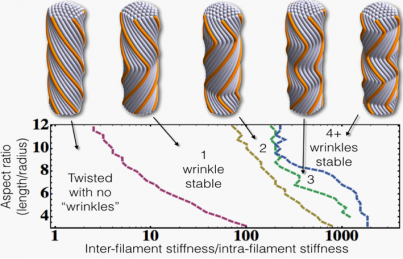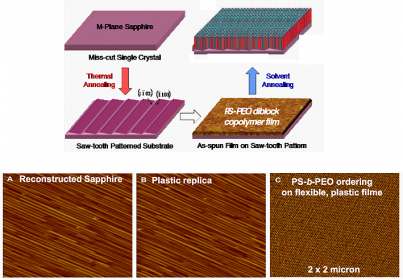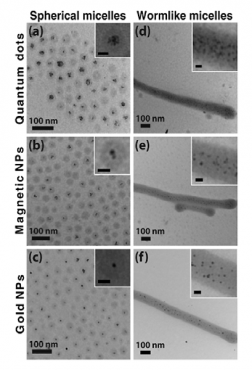Directed Polymer-based Assemblies
Coordinators: Todd Emrick (PSE) and Tom Russell (PSE)
Participants: Michael Barnes (Chemistry), Al Crosby (PSE), Tony Dinsmore (Physics), Greg Grason (PSE), Sam Gido (PSE), Ryan Hayward (PSE), Tom McCarthy (PSE), Muthukumar (PSE), Vince Rotello (Chemistry), S. Thayumanavan (Chemistry), and D. Venkataraman (Chemistry).
MRSEC research in IRG I, Directed Polymer-based Assemblies, addressed fundamental challenges in polymer-based materials assembly through a multidisciplinary approach that merges synthetic, physical, and theoretical aspects of nanoscale materials on the topic of materials directed assembly.
The project deepened our understanding of the promise of directed assembly for nanostructured materials, ranging from filamentous bundles to multi-length scale sheets to copolymer assemblies, each participating in assembly modes triggered by selection of specific internal or external directors. By directing the 2-D and 3-D spatial distribution, orientation, and ordering of polymer-based structures, novel architectures and materials arise, generating platforms that underpin the production of smaller, faster, and more efficient devices. IRG 1 research generated >200 peer-reviewed publications acknowledging the Center, with highlights including: 1) Shape transitions in filamentous bundles; 2) faceted substrates that direct polymer alignment into ultradense arrays; 3) using polymers to dictate nanoparticle placement polymeric materials.
Shape transitions in filamentous bundles
 Theory-based materials assembly in IRG 1 extends to shape transitions in filamentous bundles, in which Grason uncovered mathematical mapping between packing properties in filamentous assemblies and 2D assembly on curved surfaces, thus opening new opportunities for experimentalists. New efforts involve templating the complex 3D shape of cohesive filament bundles through control of lattice defect type, number and position in cross-sectional packing, or the filamentary analog of defect-driven buckling of 2D crystalline membranes. Five-fold disclinations in lattice packing show the analogue of conical buckling of membranes to be spontaneous twisting of filament bundles. The degree of twisting is sensitive to bundle size, length, inter-filament forces and intra-filament stiffness (Fig. 1). This work provides a theoretical underpinning for using the design of 2D cross-sections of filamentous assembly to predictably control self-organization and responsiveness in 3D. Experiments of Hayward and Russell exploit these emerging design principles in lithographically structured gel- and elastomer-based filament structures, while Crosby and Emrick are identifying new individual filament materials that consisting of cross-linked nanoparticles that produce bundled structures.
Theory-based materials assembly in IRG 1 extends to shape transitions in filamentous bundles, in which Grason uncovered mathematical mapping between packing properties in filamentous assemblies and 2D assembly on curved surfaces, thus opening new opportunities for experimentalists. New efforts involve templating the complex 3D shape of cohesive filament bundles through control of lattice defect type, number and position in cross-sectional packing, or the filamentary analog of defect-driven buckling of 2D crystalline membranes. Five-fold disclinations in lattice packing show the analogue of conical buckling of membranes to be spontaneous twisting of filament bundles. The degree of twisting is sensitive to bundle size, length, inter-filament forces and intra-filament stiffness (Fig. 1). This work provides a theoretical underpinning for using the design of 2D cross-sections of filamentous assembly to predictably control self-organization and responsiveness in 3D. Experiments of Hayward and Russell exploit these emerging design principles in lithographically structured gel- and elastomer-based filament structures, while Crosby and Emrick are identifying new individual filament materials that consisting of cross-linked nanoparticles that produce bundled structures.
Ultradense polymer arrays via faceted substrates
 Center researchers found that faceted substrates, such as miscut sapphire, direct block copolymer assembly into ultradense arrays, affording addressable nanoscale elements with near perfect order over macroscopic length scales. For example, as illustrated in the figure below, poly(styrene-block-ethylene oxide) (PS-b-PEO) copolymers were spin-coated onto these non-conventional substrates, and ordering was achieved by solvent annealing to afford highly aligned or oriented cylinders standing normal to the underlying substrate. Atomic force microscopy images show 3 nm PEO cylinders are thus oriented in a PS matrix, with an areal density of greater than 10 terabits-per-square-inch, representing a large increase over previously realized densities. It is crucial that such processes be converted to scalable roll-to-roll systems, which will be feasible owing to the ability to transfer these high density assemblies to plastic substrates, such as the replica shown in the figure, in which the saw-tooth pattern on sapphire was transferred to a poly(butylene terephthalate) (PBT) substrate, with identical ordering observed on the plastic material.
Center researchers found that faceted substrates, such as miscut sapphire, direct block copolymer assembly into ultradense arrays, affording addressable nanoscale elements with near perfect order over macroscopic length scales. For example, as illustrated in the figure below, poly(styrene-block-ethylene oxide) (PS-b-PEO) copolymers were spin-coated onto these non-conventional substrates, and ordering was achieved by solvent annealing to afford highly aligned or oriented cylinders standing normal to the underlying substrate. Atomic force microscopy images show 3 nm PEO cylinders are thus oriented in a PS matrix, with an areal density of greater than 10 terabits-per-square-inch, representing a large increase over previously realized densities. It is crucial that such processes be converted to scalable roll-to-roll systems, which will be feasible owing to the ability to transfer these high density assemblies to plastic substrates, such as the replica shown in the figure, in which the saw-tooth pattern on sapphire was transferred to a poly(butylene terephthalate) (PBT) substrate, with identical ordering observed on the plastic material.
Dictating nanoparticle placement in nanocomposites
 The similar size scale of nanoparticles and polymer chains, and the ability to tailor the chemistry of each, provides a tremendous opportunity to control enthalpic and entropic interactions and afford well-defined self-assembled structures. In collaborative work of Hayward, Emrick, and Ribbe, hydrophobic NPs were encapsulated within amphiphilic block copolymer micelles formed through instabilities at the interface of water and the selected organic solvent. This assembly process proved amenable to numerous particle compositions - CdSe quantum dots and nanorods, Fe2O3 nanoparticles, and Au nanoparticles – by emulsification in water and amphiphilic block copolymers such as poly(styrene-block-ethylene oxide). Solvent evaporation led to a near vanishing interfacial tension, and ultimately polymer micelles, through instabilities of the solvent/water interface, generating nanoparticle-loaded wormlike or spherical micelles. Remarkably, this process was insensitive to NP surface chemistry, with similar results obtained for NPs functionalized with their native alkane ligands and those with custom-synthesized polystyrene ligands that match the chemistry of the hydrophobic block. Thus, simply having hydrophobic ligands leads to the desired interfacial interactions and efficient NP encapsulation. TEM and energy-dispersive X-ray (EDX) spectroscopy further confirmed NP co-localization within the hybrid micelle core.
The similar size scale of nanoparticles and polymer chains, and the ability to tailor the chemistry of each, provides a tremendous opportunity to control enthalpic and entropic interactions and afford well-defined self-assembled structures. In collaborative work of Hayward, Emrick, and Ribbe, hydrophobic NPs were encapsulated within amphiphilic block copolymer micelles formed through instabilities at the interface of water and the selected organic solvent. This assembly process proved amenable to numerous particle compositions - CdSe quantum dots and nanorods, Fe2O3 nanoparticles, and Au nanoparticles – by emulsification in water and amphiphilic block copolymers such as poly(styrene-block-ethylene oxide). Solvent evaporation led to a near vanishing interfacial tension, and ultimately polymer micelles, through instabilities of the solvent/water interface, generating nanoparticle-loaded wormlike or spherical micelles. Remarkably, this process was insensitive to NP surface chemistry, with similar results obtained for NPs functionalized with their native alkane ligands and those with custom-synthesized polystyrene ligands that match the chemistry of the hydrophobic block. Thus, simply having hydrophobic ligands leads to the desired interfacial interactions and efficient NP encapsulation. TEM and energy-dispersive X-ray (EDX) spectroscopy further confirmed NP co-localization within the hybrid micelle core.


